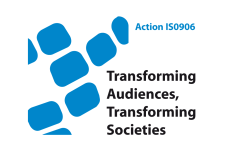- About the Action
- Events
- PhD workshop - Ljubljana 2014
- Action Open Conference - Ljubljana 2014
- New Media and Participation conference - Istanbul 2013
- Belgrade meeting 2013
- Media literacy research and policy - Brussels 2013
- ICA Pre-Conference 2013
- Tampere meeting 2013
- Budapest workshop 2012
- Milan meeting 2012
- Brussels PhD workshop 2012
- Brussels Action workshop 2012
- London meeting 2011
- Zagreb Conference 2011
- Lisbon meeting 2010
- Affiliated events
- WG 1
- WG 2
- WG 3
- WG 4
- Cross-WG
- Output
De la práctica a la experiencia de ocio: innovaciones necesarias en el estudio de las audiencias televisivas
Landabidea Urresti, X., Aristegi Fradua, Iratxe; Madariaga Ortuzar, Aurora (2012). De la práctica a la experiencia de ocio: innovaciones necesarias en el estudio de las audiencias televisivas. Ortega Nuere, Cristina; San Salvador del Valle Doistua, Roberto(Eds.). Ocio e innovación para un compromiso social, resposanle y sostenible., 93-110Bilbao: Universidad de Deusto.
http://blogs.deusto.es/DeustoLibros/ocio-e-innovacion-para-un-compromiso-social-...Abstract: Media-related leisure activities are prevalent in our society, both as regards the time devoted to them, as well as their geographical socio-demographic extension. In terms both of time and space, it can be argued that the presence and influence of audio-visual texts has increased as displays have become smaller, more abundant and easier to transport. Consistent with the trend started in the second half of the XXth century, television is today the dominant medium regarding these two criteria, to the point that when studying leisure practices in Basque society studying television is inescapable. Television remains at the crossroads of media, bat its centrality is already being questioned. It is nowadays increasingly difficult to describe XXIst century citizens´ leisure without considering the consumption, production and participation in media texts and without taking into account the continuously changing media ecosystem. Technological and social changes have completely changed television´s position in the media ecosystem, giving way to what has been called as convergent culture (Jenkins, H., 2006). But more importantly, the position of the television has shifted in relation to the audience. Juan Freire will relate this change to the Information and Communication Technologies associated with the "new sociotechnical paradigm” of post digital culture (Freire, J., 2010). Television has changed due to technological and social innovation, and therefore it could be argued that leisure relations people establish with the TV have also changed as well. In this context, the traditional approaches to the quantitative analysis of the audience that measure practices related to television are not enough anymore, it is needed to go beyond using different methodologies in order to approach leisure experiences people live in relation to TV. This paper argues that an innovation in audience research that will be up to the socio-technical innovation is absolutely necessary in order to understand the position of TV in society. A model for the exploration of the roles media in general and television in particular play in everyday life will be presented: the three vertex model.

